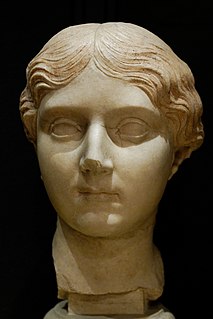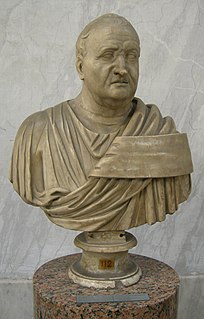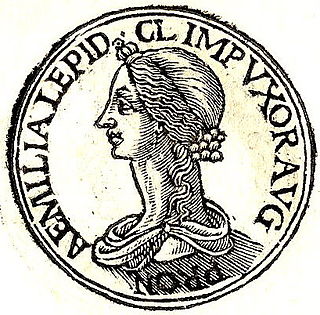Related Research Articles

Julia Agrippina, also referred to as Agrippina the Younger, was a Roman empress and one of the most prominent women in the Julio-Claudian dynasty. Her father was general Germanicus, one-time heir apparent to the Roman Empire under Tiberius and her mother was Agrippina the Elder, a granddaughter of the first Roman emperor Augustus. She was the younger sister of emperor Caligula, the niece and fourth wife of emperor Claudius who succeeded Caligula, and the mother of emperor Nero, who succeeded Claudius.

The Julio-Claudian dynasty comprised the first five Roman emperors: Augustus, Tiberius, Caligula, Claudius, and Nero. They ruled the Roman Empire from its formation under Augustus in 27 BC until AD 68, when the last of the line, Nero, committed suicide. The name "Julio-Claudian" is a historiographical term derived from the two families which composed the imperial dynasty: the Julii Caesares and Claudii Nerones.

Marcus Vipsanius Agrippa was a Roman general, statesman, and architect. He was a close friend, son-in-law, and lieutenant to Augustus and was responsible for the construction of some of the most notable buildings in the history of Rome and for important military victories, most notably at the Battle of Actium in 31 BC against the forces of Mark Antony and Cleopatra. As a result of these victories, Octavian became the first Roman Emperor, adopting the name of Augustus Caesar. Agrippa assisted Augustus in making Rome "a city of marble" and renovating aqueducts to give all Romans, from every social class, access to the highest quality public services. He was responsible for the creation of many baths, porticoes, and gardens, as well as the original Pantheon. Agrippa was also husband to Julia the Elder, maternal grandfather to Caligula, and maternal great-grandfather to the Emperor Nero.

Antonia the Elder was a niece of the first Roman emperor Augustus, being the eldest daughter of Octavia the Younger and her second husband the Triumvir Mark Antony. She married Lucius Domitius Ahenobarbus and became the maternal grandmother of empress Messalina as well as paternal grandmother of the emperor Nero.
Marcus Junius M. f. M. n. Silanus, was the eldest son of Marcus Junius Silanus Torquatus and Aemilia Lepida. His mother was the great-granddaughter of the emperor Augustus. As a member of the imperial family, Silanus could therefore be considered a possible candidate for the succession.
Decimus Junius Silanus Torquatus was a Roman senator who lived during the 1st century. He served as an ordinary consul in 53 with Quintus Haterius Antoninus as his colleague. Decimus was the second son born to Aemilia Lepida and Marcus Junius Silanus Torquatus, a member of the Junii Silani, a family of Ancient Rome.

Domitia Lepida, also known as Domitia Lepida the Younger, or Domitia Lepida Minor, ; was the younger daughter of consul, Lucius Domitius Ahenobarbus and Antonia Major. Her elder sister was Domitia Lepida the Elder and her younger brother was Gnaeus Domitius Ahenobarbus, father of the Emperor Nero. She was the great niece of Emperor Augustus, granddaughter of Octavia the Younger and Triumvir Mark Antony, second cousin to the Emperor Caligula, first cousin and mother-in-law to the Emperor Claudius and paternal aunt of the Emperor Nero. Lepida was a beautiful and influential figure. Like her sister, she was also very wealthy. She had holdings in Calabria and owned the praedia Lepidiana.

Gnaeus Domitius Ahenobarbus was a member of the imperial Julio-Claudian dynasty of Ancient Rome. Domitius was the son of Antonia Major. He married Agrippina the Younger and became the father of the Emperor Nero.

Domitia, more commonly referred to as Domitia the Elder -- in fact no ancient source ever calls her Lepida - was the oldest child of Antonia Major and Lucius Domitius Ahenobarbus, and the oldest granddaughter to triumvir Mark Antony by Octavia Minor, a great-niece of the Roman Emperor Augustus, second cousin and sister-in-law to the Emperor Caligula, first cousin to the Emperor Claudius, maternal aunt to the Empress Valeria Messalina, and paternal aunt to Emperor Nero.
Two noblemen, an uncle and nephew, who shared the name Lucius Junius Silanus Torquatus and were descendants of the Roman Emperor Augustus, lived during the 1st century AD.
Junia Calvina was a Roman noblewoman who lived in the 1st century AD. The daughter of Aemilia Lepida and Marcus Junius Silanus Torquatus, consul in 19, Calvina belonged to two patrician houses: the gens Aemilia and gens Junia respectively. She was also the great-great-granddaughter of the Roman emperor Caesar Augustus on her mother's side of the Imperial family. As such, she was also related by blood to the gens Julia, the aristocratic family of the Roman dictator Julius Caesar. Tacitus calls Calvina "festivissima puella" and the Emperor Vespasian, in one of his jokes, mentions her as living in AD 79. Seneca describes her as "most celebrated of all women ."
Junia Lepida was a Roman noblewoman who lived in the first century. She was the second daughter of Aemilia Lepida and Marcus Junius Silanus Torquatus, one of the Junii Silani. Her maternal grandparents were Julia the Younger, granddaughter of the emperor Augustus, and Lucius Aemilius Paullus, consul in AD 1.
Aemilia Lepida is the name of several ancient Roman women belonging to the gens Aemilia. The name was given to daughters of men belonging to the Lepidus branch of the Aemilius family. The first Aemilia Lepida to be mentioned by Roman historians was the former fiancée of the younger Cato. Subsequent Aemiliae are known because of their marriages.

The gens Junia was one of the most celebrated families of ancient Rome. The gens may originally have been patrician, and was already prominent in the last days of the Roman monarchy. Lucius Junius Brutus was the nephew of Lucius Tarquinius Superbus, the seventh and last King of Rome, and on the expulsion of Tarquin in 509 BC, he became one of the first consuls of the Roman Republic.
Silanus was the cognomen of a branch of the Junia gens, a noble family of ancient Rome which came to prominence during the Second Punic War, and remained important into imperial times. Some notable members include:
Lucius Aemilius Paullus was the son of Paullus Aemilius Lepidus and Cornelia, the elder daughter of Scribonia. He was married to Julia the Younger, the eldest granddaughter of the Emperor Augustus.
Appius Junius Silanus, whom Cassius Dio calls Gaius Appius Silanus, was consul in AD 28, with Publius Silius Nerva as his colleague. He was accused of majestas, or treason, in AD 32 along with a number of senators, but he and Gaius Calvisius Sabinus were saved by one of the informers, Celsus, a tribune of a city cohort.

Aemilia Lepida was a noble Roman woman and matron. She was the first great-grandchild of the Emperor Augustus.
Marcus Junius D. f. M. n. Silanus was a Roman senator and consul in 25 BC as the colleague of Gaius Julius Caesar Octavianus, the emperor Augustus.
References
- ↑ Attilio Degrassi, I fasti consolari dell'Impero Romano dal 30 avanti Cristo al 613 dopo Cristo (Rome, 1952), p. 8
- ↑ Oxford Classical Dictionary , 2nd Ed. (1970).
- ↑ Realencyclopädie der Classischen Altertumswissenschaft .
- ↑ Oxford Classical Dictionary , 2nd Ed. (1970).
- ↑ Ronald Syme, "The Early Tiberian Consuls", Historia: Zeitschrift für Alte Geschichte , 30 (1981), pp. 196f.
- ↑ Syme, The Augustan Aristocracy (Oxford: Clarendon Press, 1986), pp. 188, 192
- ↑ Barrett, Anthony, Caligula: The Corruption of Power (Touchstone, 1989), p.viii-ix.
- ↑ Gemäß R. Hanslik, Iunius 27. I. Silana, in: Der Kleine Pauly, Bd. 2 (1967), Sp. 1561.
| Political offices | ||
|---|---|---|
| Preceded by Gaius Rubellius Blandus, and Marcus Vipstanus Gallus as Suffect consuls | Consul of the Roman Empire 19 with Lucius Norbanus Balbus, followed by Publius Petronius | Succeeded by Marcus Valerius Messala, and Marcus Aurelius Cotta Maximus Messalinus as Ordinary consuls |